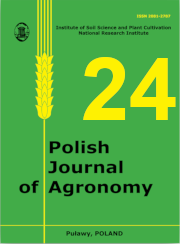Phytotoxicity of pyridineamidoximes against two crop plants: preliminary evaluation
Main Article Content
Abstract
The study involved the analysis of the impact of pyridineamidoximes on the germination and early development of plants belonging to different taxonomic units (monocots and dicots). maize (Zea mays) and sunflower (Helianthus annuus) were selected as the objects. Culture was carried out in vertical plastic PhytotoxkitTM containers (Phytotoxkit, Tigret company, Belgium). number of germinated seeds, root length and shoot height were recorded. Based on the results, germination index and percentage inhibition of roots and shoots growth were calculated. 2-, 3- and 4-pyridineamidoximes showed varied influence on the plants under study. Generally the toxic effect of pyridineamidoximes on the plants depends on both the position of the functional group in the pyridine ring, as well as on the concentration of the compound used. The results showed a higher susceptibility of sunflower vs. maize to the compounds. Phytotoxic response in maize occurred typically at the highest concentration (above 500 mg kg-1 d.w.s.), while the sunflower symptoms inhibition due to the presence of the test compounds occurred at the lowest (25 and 50 mg kg-1 d.w.s.) and the highest (1000 mg kg-1 d.w.s.) concentration.
Article Details

This work is licensed under a Creative Commons Attribution-ShareAlike 4.0 International License.
The author grants the editorial staff of the Polish Journal of Agronomy (abbreviated as PJA) a non-exclusive and royalty-free license to use the author's copyright in the paper/printed and electronic versions of his/her work published in PJA in Poland and abroad, in whole or in any part, including placing the work in electronic databases/databases locally or available on the Internet, for an unlimited period of time in the fields of exploitation specified in article 50 of the Copyright and Related Rights Act.
Manuscripts published in Polish Journal of Agronomy are available under a Creative Commons Attribution-ShareAlike 4.0 (CC-BY-SA) license.

